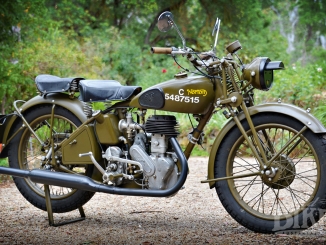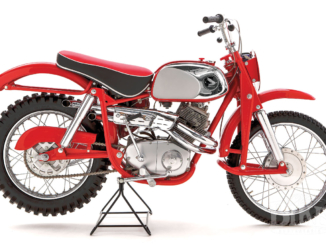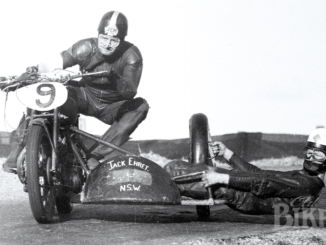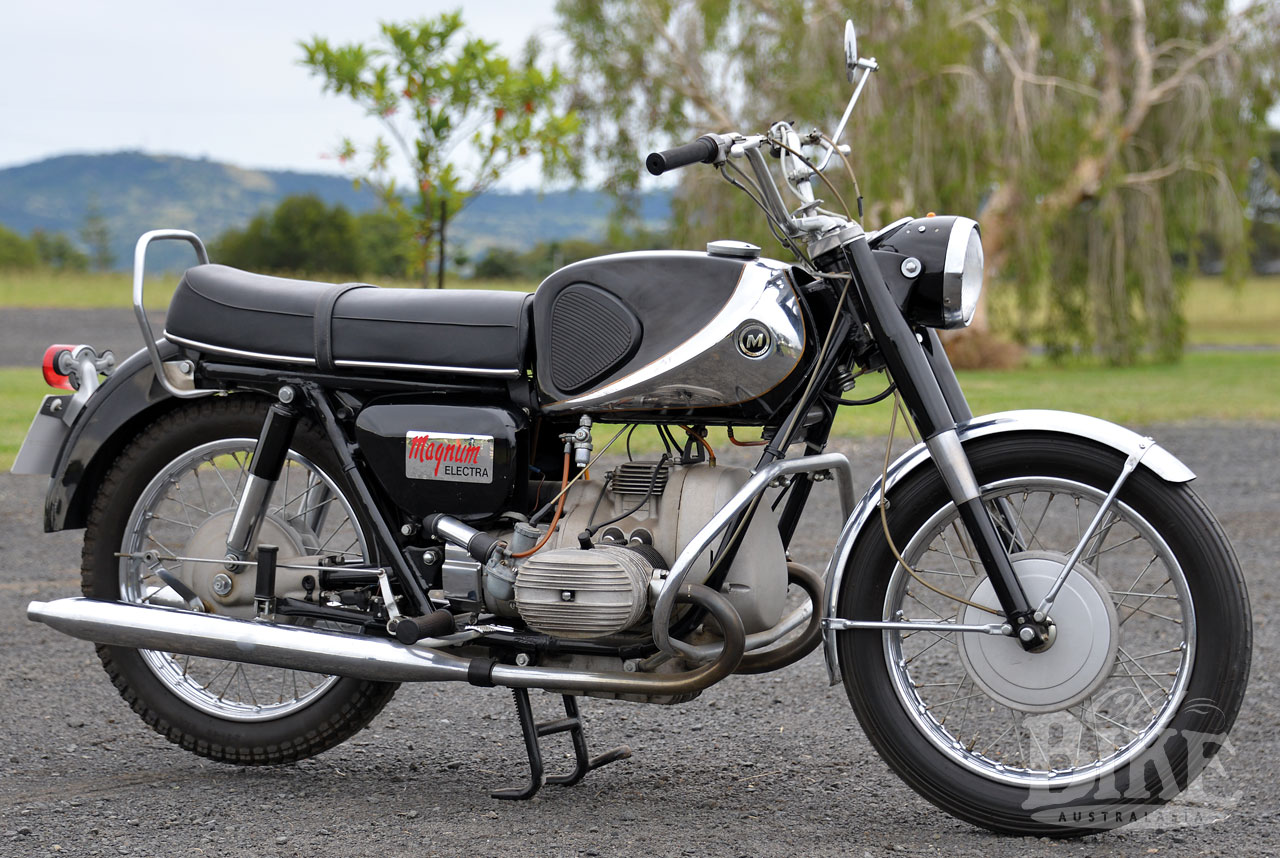
Besides the Japanese motorcycle manufacturers that exist today, there were plenty of smaller producers who left the scene, particularly in the late 1950s. They went out of business, merged with other companies, were taken over, or diversified to other products, often disappearing without leaving a mark outside Japan. Marusho, later known as Lilac, was one of these manufacturers who managed to introduce some unusual, innovative and sophisticated bikes to the western world markets before becoming extinct mid 1960s. With sales mostly in the Japanese home market, more than 50,000 motorcycles were produced during the 17 years of production. Over thirty different models were made, with the company’s golden years being 1955 to 1960.
Story: Andrew Brockhoff and Jim Scaysbrook • Photos: Jim Scaysbrook, Andrew Brockhoff and Ray Tubman.
By all accounts, Marusho’s founder and president, Masashi Ito (born in 1913) and Soichiro Honda were good mates. Ito worked at Honda’s automobile repair shop from 1930-1935 while also studying metallurgy, and by the time he was 27, he and his elder brother had struck out on their own and opened a small repair business in Hamamatsu. Before this could become established the war intervened, but Ito was back in business in 1946, repairing cars and supplying bodywork, mainly light truck cabins, to companies such as Toyota and Nissan.
It could have been a comfortable existence, but like Honda, Ito’s passion was to make motorcycles. In 1948 Ito formed Marusho Shokai Co. Ltd. for expressly that purpose. The name itself is interesting, being formed from maru, meaning (in Japanese) circular, but also harmony, and sho, meaning correct or honest. The company’s badge was a circle with the Chinese character for sho. It took two more years before the prototype ML was ready, and like many of his countrymen, Ito drew inspiration from a number of European designs, particularly the German marques Zundapp and BMW. He called his creations Lilac. It is recorded that lilacs were his wife’s favourite flower, hence the name. A better sourced version is that Lilac is derived from the family name.

The first production machine to bear the Lilac badge was the LB, a 150cc ohv single, which, like almost all his designs, employed shaft final drive. This was in 1951 and the company was renamed Marusho Motorcycle Industrial Co. Ltd. Finance was so tight that Marusho could only build bikes to order, with payment in advance. There were no dealers so buyers had to collect their new machines from the factory, and return them for servicing. Very Teutonic in appearance, the 150 used a pressed steel frame with rigid rear end and telescopic front forks. The engine and gearbox were built in-unit and were very BMW-like. A total of 496 motorcycles were built in 1951, which made Lilac the seventh largest in the Japanese market behind Honda, Meguro, Showa, Shin Meiwa, Rikuo and Asahi.
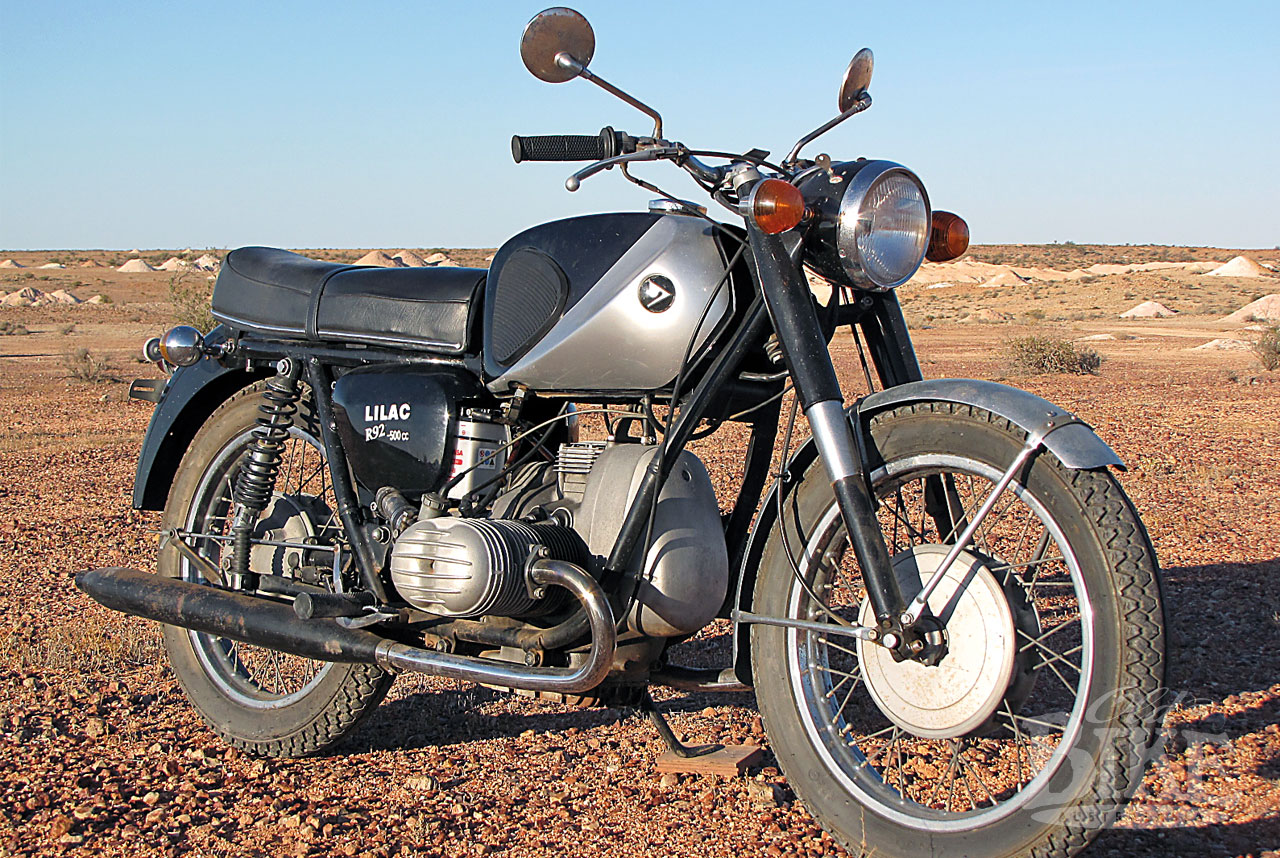
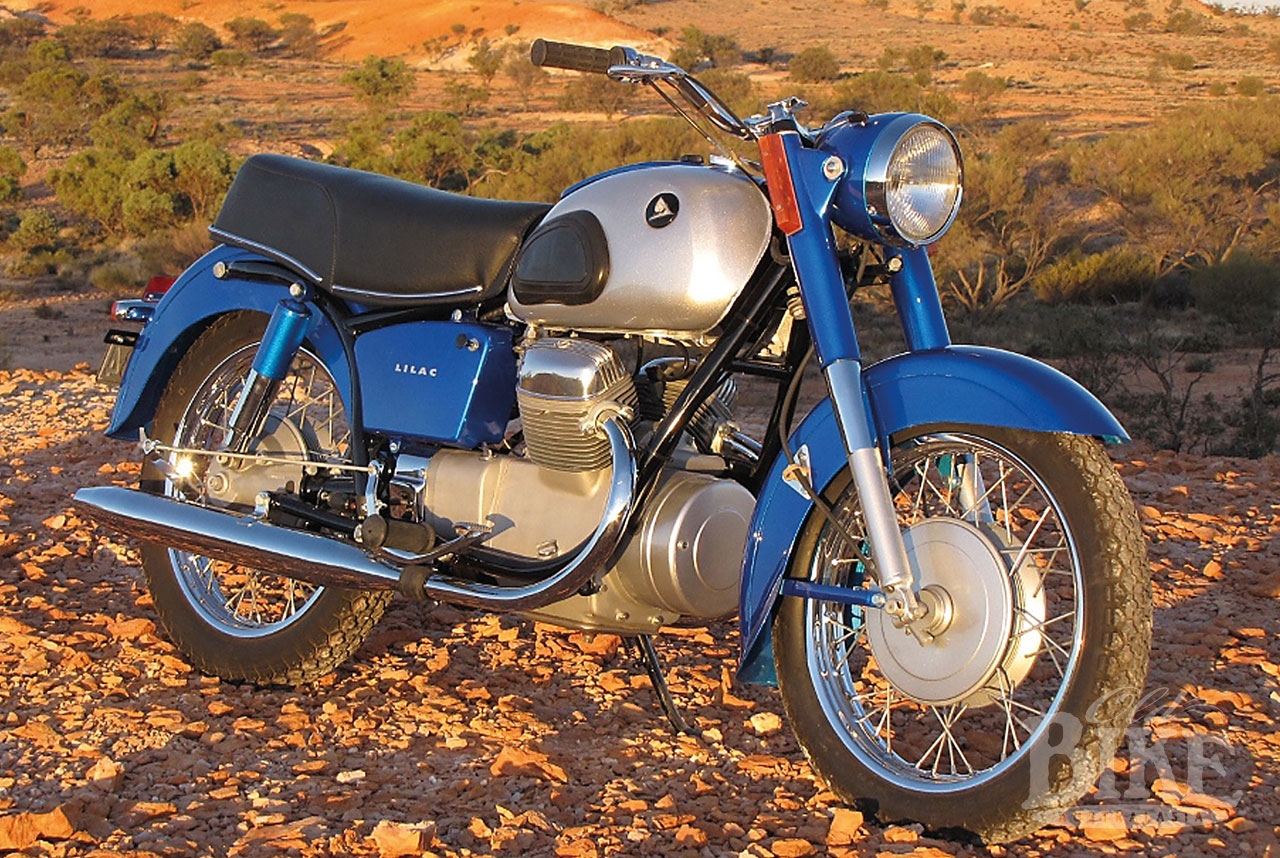
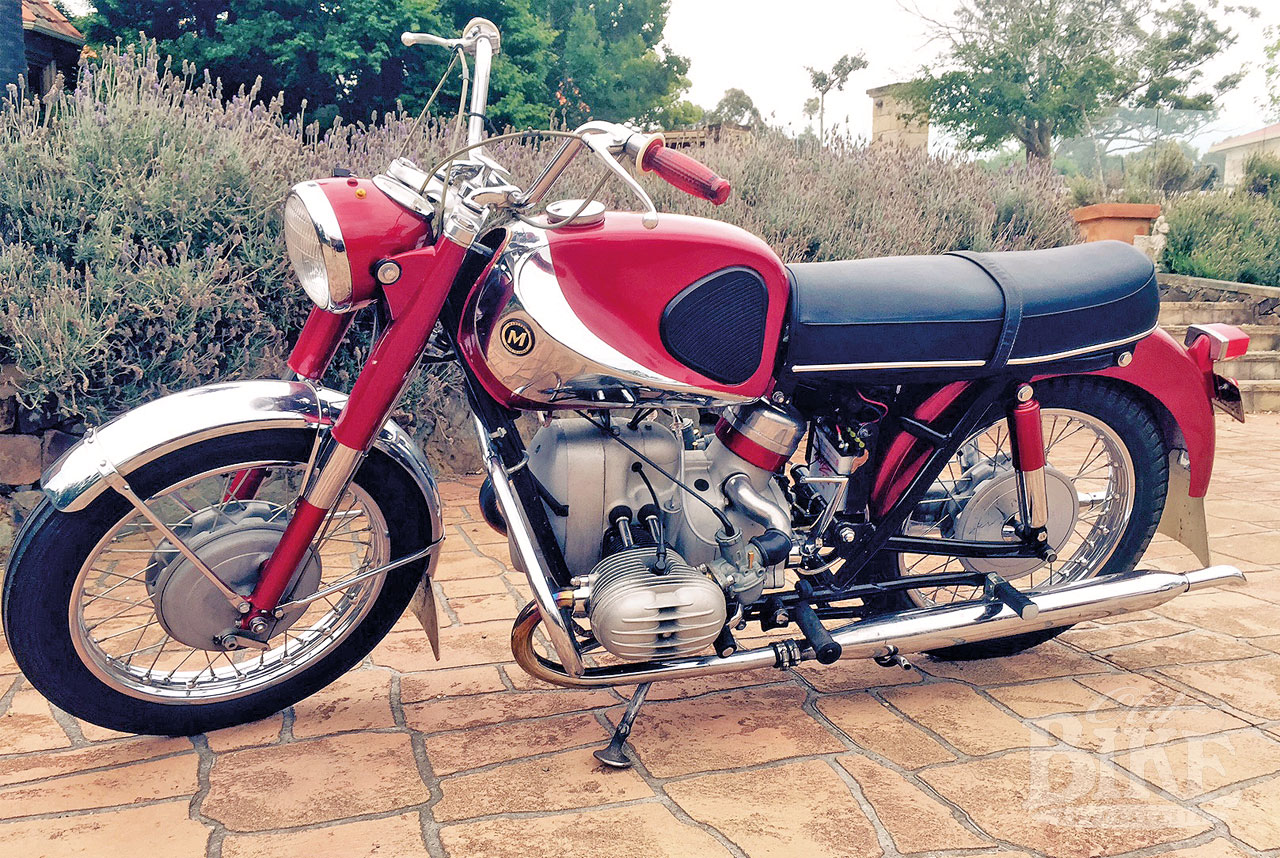
The model range designated KD/KE/KH were 150cc, 200cc and 250cc singles in tubular steel frames now with plunger rear suspension. By 1952 Marusho was ranked number four in Japan and the following year introduced the Baby Lilac – a 90cc step-through weighing 83kg which foreshadowed the style that would come to define Honda and other manufacturers. The JF Baby Lilac was an unusual looking machine. It had a large diameter backbone frame with pressed steel front and under engine sections, leading link front suspension at one stage, a headlight and fuel tank as one unit around the steering stem, thickly cushioned single seat, an odd, adjustable rear suspension, and of course, shaft drive. Advertising claimed even women and children could use it. It sold well and remained in the line-up for several years. Through the mid and late 1950s the model range included four stroke 90, 125, 175, and 250cc singles and 350cc horizontally opposed twins. There were a couple of two stroke powered smaller bikes too. However, times were tough and the range increasingly outdated, despite production hitting a record 11,000 units for 1959.

Marusho ST ad from 1965.
Ito designed a transverse cylinder V-twin which drew more than a little of its inspiration from the Victoria Bergmeister. These electric start twins, in 125cc, 250cc and 300cc versions, were imported into the USA by the California based M-C Supply Company, which reportedly took around 400 bikes between 1960 and 1961. It is estimated perhaps 200 to 250 early LS18s and ten to twenty MF39s were imported to Australia. Of these, the biggest seller by far, was the LS18 – the standard version of the 250cc bike. Its lovely, sporty sibling, the LS38 was regarded highly by the Japanese for its performance. The 54 x 54mm bore and stroke 250 was equipped with dual carburettors. With a four speed gearbox, 21hp on tap, and a top speed of 85mph, the Lilac could easily see off the big selling Honda C71. It also had electric start, quick release rear wheel, and turn signals. For the export market, two 300cc (288cc actually) versions were created by lengthening the stroke to 62mm, and fitting dual carburettors in the case of the MF39, which brought power up to 23.5hp at 7,800 rpm. The MF19 had the 288cc capacity, but with a single carby. This capacity increase was the natural thing to do with a 250 that was headed for the U.S. since it cost little and made the machine more suitable for their open roads, and where the licensing classes were not changed at 250cc. For whatever reason, there were three distinctly different 125 V-twins made in ’60-’61. By 1960 there were no single cylinder models, the whole range being V-twins.
Ito took the decision to gear up for mass production and commissioned a new factory at Hamamatsu, where production could reach 27,000 units per year. This involved massive borrowing, and the completion date for the new premises was repeatedly delayed. Ito was in real trouble. His bankers, Daiwa, tried to force an amalgamation with Suzuki, which in hindsight may not have been a bad move, but Ito simply could not face such a merger, and Daiwa turned off the funds. A large-scale arrangement with Mitsubishi to produce the Silver Pigeon Galepet scooter (the two stroke 50cc prototype AS71) fell through after Marusho had invested heavily in infrastructure, contributing to the debt burden. Despite fairly healthy sales at home and in the U.S., in October 1961, Marusho was declared bankrupt. Many of Marusho’s designers found employment with the Honda and Bridgestone motorcycle works. For Ito however, this bankruptcy was merely a setback.

In order to restructure and to pay off his debts, Ito subcontracted work for Honda but was firmly focused on re-entering the field of motorcycle production. During 1962 and 1963 a small number of bikes were pieced together for sale and a couple of interesting prototypes created: the M330, a 330cc V-twin, and the stylish C103/C105 horizontally opposed twins with overhead cams, dual carburettors, five speed transmissions, and capacities of 125 and 160cc. These weren’t to be, but the company was ready to put a bike into small scale production.
The company was now named Lilac Motorcycle Company Ltd. Honda was exporting to the western world and so Ito also set his sights on the U.S. and Canadian markets. Using the chassis from the LS38/MF39 V-twins, Ito came up with a machine that, apart from the fuel tank design, could easily be mistaken for a BMW R50. The engine looked very much a BMW clone, however, only a few internal parts were interchangeable with the BMW. Lilac used their own gearbox and clutch, which had been developed in many years of building shaft-driven motorcycles, with a flexible neoprene ‘doughnut’ coupling at the gearbox output shaft / driveshaft junction. This maintenance-free item featured on earlier models as well. They also developed their own ignition and electrical system. In terms of performance, Lilac’s new Marusho ST soundly trounced the R50 BMW, which produced 26hp at 5,800 rpm compared to the ST’s 35.6hp at 6,500 rpm.
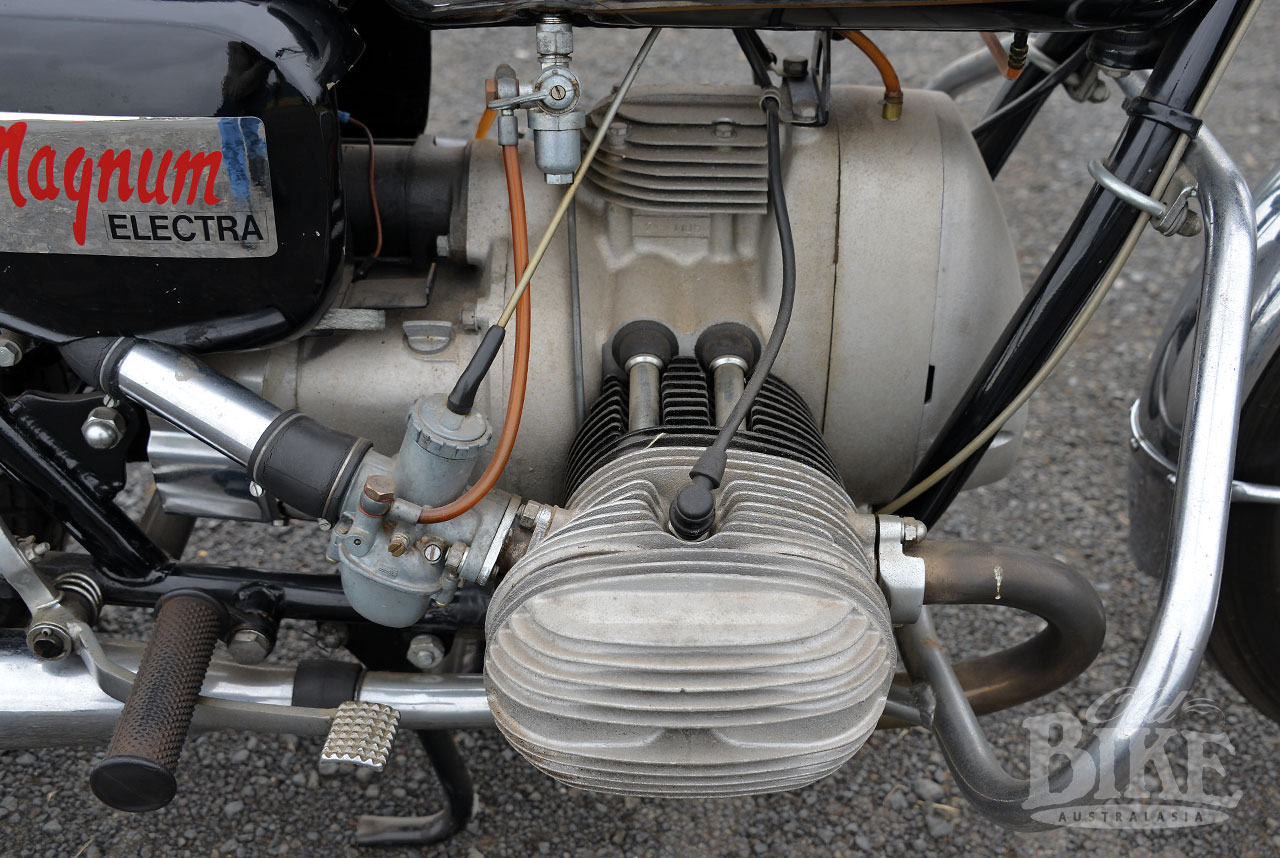
Volume manufacturing recommenced in 1964, producing only the 500cc twin cylinder Marusho ST model and a handful of V-twins assembled from leftover parts. The factory staff numbered about 30, compared to 600 prior to the 1961 bankruptcy. A distribution headquarters was set up in California and press reports of the day show Lilac’s deal with the newly-formed U.S. Marusho Corporation was for 200 of the new 500cc model landed in the U.S. per month. This target was never met. The new Marusho flat twin was initially called the Imperial. This was soon changed to ST (Sports Touring), and was somewhat of a hit in the U.S., where it sold for $995.00 through franchised outlets including small shops and hardware stores, undercutting most other models in the 500cc category. In fact, the U.S. demand was so strong that few of the 600-odd produced in 1965 were sold elsewhere.
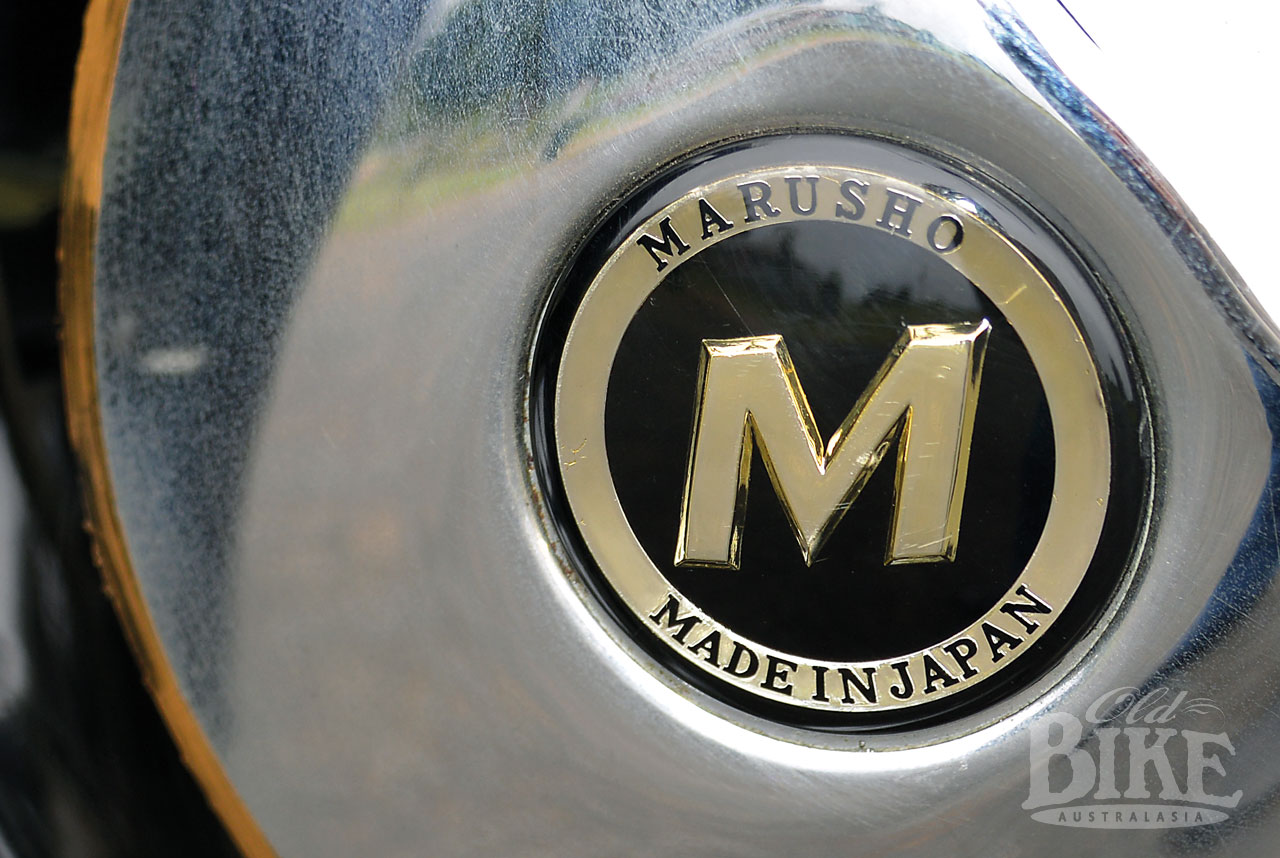
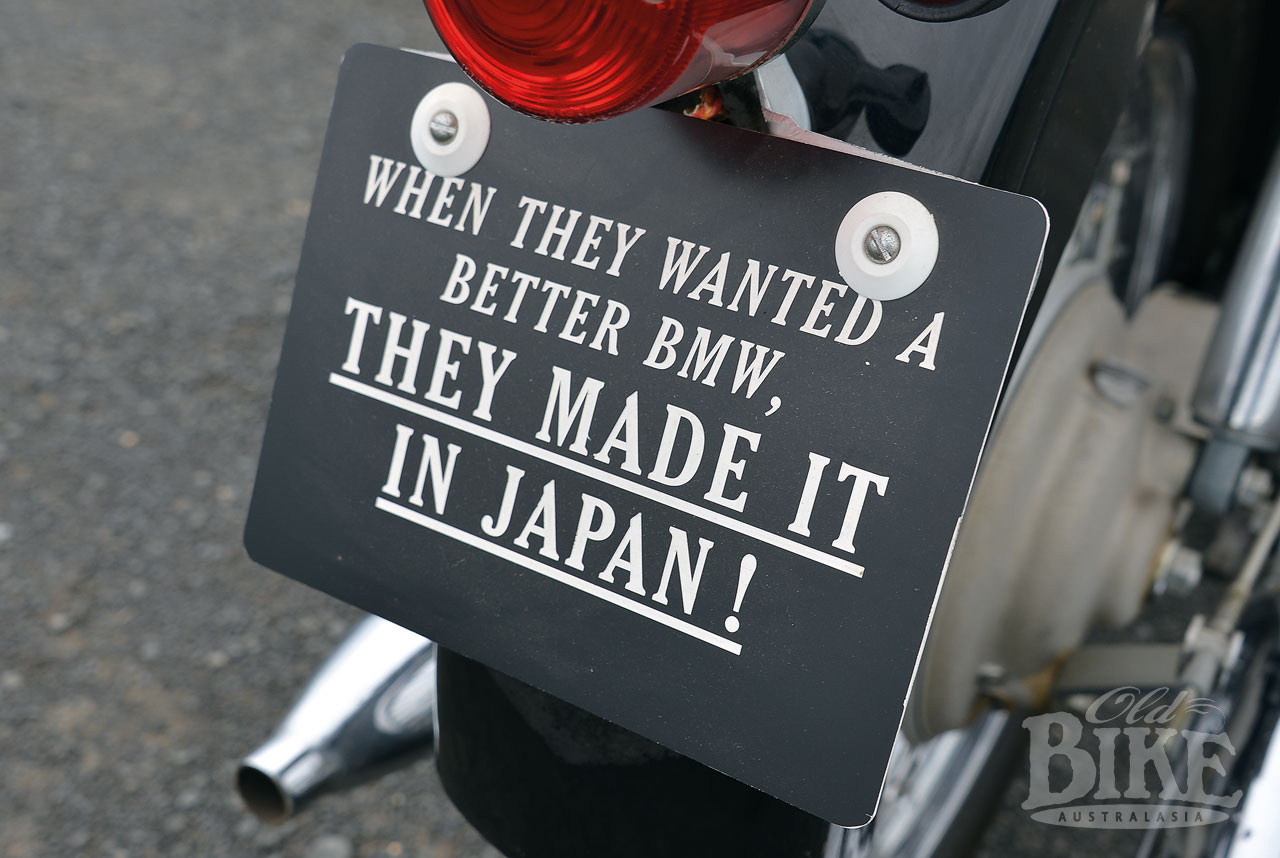

These bikes were rushed into production and Lilac paid the price for inadequate development time. Faults that should have been addressed as teething troubles before release made the basically well built machines unreliable. As there initially was a lack of spare parts backup, new bikes were cannibalised to keep customers on the road. The ignition timing advance/retard unit repeatedly failed, causing the company no end of warranty problems. The quick cure was to replace the Lilac component with a BMW genuine part, which was extremely expensive and neither Lilac nor U.S. Marusho implemented this change. Generators were troublesome, and rear drive components, from a well known supplier, had quality issues. The clamour over the mechanical problems with the ST increased to such an extent that Ito flew to Los Angeles to try and straighten things out.
Seeking to include performance-minded buyers, the subsequent 1966 model Magnum was updated in several ways. Most noticeably 28mm carburettors replaced the ST’s 22mm ones, compression ratio was increased with improved cylinders and revised camshaft which resulted in claims of 40hp and 100mph top speed. This performance increase was used prominently in advertising. (Power and top speed figures listed in brochures for the 500cc models are “rubbery”, but later models were quicker than the ST). The alloy cylinders were painted black mimicking those on the sport model BMW R69S.

The third and final model, the Magnum Electra carried some changes designed in the U.S. under U.S. Marusho Corp. head man Genichiro ‘Roy’ Hiraishi. The Marusho, now $1,195.00 in the U.S., featured an electric starter, so in that respect, it was way ahead of its BMW lookalike. The starter fired up the engine by engaging a ring gear on the flywheel, car-style, but the kick starter was retained, just in case. The push-button starting was not the only change however; the engine featuring a cartridge style oil filter as was becoming fashionable, more robust looking cylinders with thicker liners, and several cosmetic styling changes. Strangely, U.S. Marusho’s advertising carried the line that the “500cc cycle can be bored to 600cc”. The positioning of the electric starter necessitated a re-design of the air filter. The earlier air filter incorporated the choke, whereas the Magnum Electra had no cold start choke fitted at all. This model was only available in black, whereas the ST was standard in black and silver, and the Magnum (fully black), were both available in the attractive optional candy apple red. Performance impressed the motorcycling press test riders; the 500cc tourer achieving a ¼ mile standing start time of 15.7 seconds with a terminal speed of 84mph according to a Cycle World report.
Despite the ST’s encouraging sales in 1965, production of the Marusho Magnum dropped to just 180 units in 1966 and only 123 Magnum Electras were built for the model year 1967. Much of this problem was due to the growing frustration of component suppliers in Japan, who demanded full cash payment before they would supply the factory. Unable to fulfil their agreement to take and sell the contracted number of bikes per month, the U.S. Marusho operation faced the wrath of the banks as well, and in late 1966 the finance dried up. Lilac collapsed for the second and final time in early 1967. Ito resigned from the company, which was taken over by one of the remaining employees, and the factory’s efforts switched from making motorcycles to household appliances such as rice cookers. Ito’s and his wife’s personal savings went towards paying the company’s creditors. The couple lived in retirement in a small Hamamatsu apartment building they owned and Ito, a pioneer of the Japanese motorcycle industry, passed away in 2005, aged 92. It is widely reported that the company’s unofficial slogan was “Engineering first, Sales second.” An admirable philosophy, but hardly a recipe for success.

The featured motorcycle is a U.S. model, one of the very last made. Over the three-model run of the 500cc Marushos, perhaps about fifty of the near 900 bikes produced were badged Lilac (model R92) for the home and other markets. All Australian-delivered 500s were Lilacs and were fitted with directional indicators (blinkers) and lower handlebars. As tested locally in 1968, the Lilac Electra drew faint praise for its performance, but harsh criticism for the spongy brakes. (Perhaps to compensate for the brakes, the headlight is bright and the horn incredibly loud!). The motorcycle received the biggest commendation for engine performance, stated to be superior in both low down torque and acceleration than the equivalent BMW, and with less vibration. Handling met with approval too. This was the very first bike tested by the new Two Wheels magazine. The rather firm gear change is ‘four down’, with neutral at the top. Besides a neutral light, there is a warning light to indicate when in third gear. This would be a leftover from the earlier V-twins’ and ST’s rotary shift pattern, where neutral comes after fourth. Perhaps the engineers thought it a useful feature to keep.
When the partnership with U.S. Marusho Corp. finished, the last handful of bikes to leave the factory were all badged Lilac. Possibly eight, but at least six of these came to Australia, packed two to a crate. Two were imported through Modak Motorcycles, Melbourne and the others through Mahler Motors, Sydney. Asking price was $925. Six bikes are still around; one of which has been exported to the UK.
At present there are about ten Marusho/Lilac 500s known of in Australia, making our featured machine, owned by John King (former owners Allen and Lorraine Smith) quite rare indeed. These elegant and well finished bikes today find homes with collectors who are attracted by their uniqueness as much as anything else. One will appear for sale on the internet every few months, mainly in the U.S. naturally. It is estimated that more than half of all Marusho 500s still exist, in various condition. An informative website; marusholilac.com and a register of these motorcycles is maintained by Ralph Walker in Virginia, USA.
Specifications: 1967 Marusho Magnum Electra / Lilac R92 Electra
Engine: Horizontally opposed ohv twin
Bore x stroke: 68mm x 68mm
Capacity: 493cc
Compression ratio: 9.6:1
Carbs: Mikuni VM28
Power: 40hp at 7,000rpm
Gears: 4 speed
Wheels/tyres: Front 3.25 x 18, Rear 3.50 x 18
Suspension: Front telescopic forks, rear swinging arm
Wheelbase: 1402mm
Fuel tank capacity: 15 litres
Weight: 188kg
Colour: Black only


